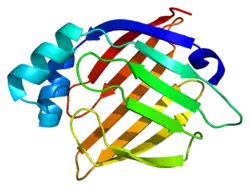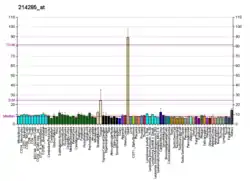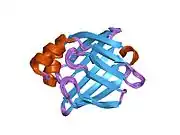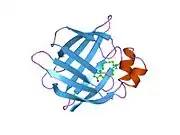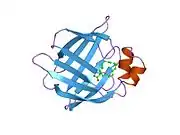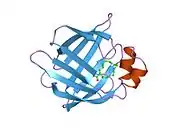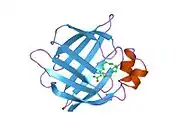Heart-type fatty acid binding protein
Heart-type fatty acid binding protein (hFABP) also known as mammary-derived growth inhibitor is a protein that in humans is encoded by the FABP3 gene.[4][5]
Function
Heart-type Fatty Acid-Binding Protein (H-FABP) is a small cytoplasmic protein (15 kDa) released from cardiac myocytes following an ischemic episode.[6] Like the nine other distinct FABPs that have been identified, H-FABP is involved in active fatty acid metabolism where it transports fatty acids from the cell membrane to mitochondria for oxidation.[6] See FABP3 for biochemical details.
The intracellular fatty acid-binding proteins (FABPs) belongs to a multigene family. FABPs are divided into at least three distinct types, namely the hepatic-, intestinal- and cardiac-type. They form 14-15 kDa proteins and are thought to participate in the uptake, intracellular metabolism and/or transport of long-chain fatty acids. They may also be responsible in the modulation of cell growth and proliferation. Fatty acid-binding protein 3 gene contains four exons and its function is to arrest growth of mammary epithelial cells. This gene is also a candidate tumor suppressor gene for human breast cancer.[5]
Interactions
FABP3 is known to interact with TNNI3K in the context of interacting with cardiac troponin I.[7] The protein also interacts with, VPS28, KIAA159,[8] NUP62,[9] PLK1, UBC, and Xpo1.[5]
In HIV, a synthetic peptide corresponding to the immunosuppressive domain (amino acids 574-592) of HIV-1 gp41 downregulates the expression of fatty acid binding protein 3 (FABP3) in peptide-treated PBMCs.[10]
Clinical significance
Diagnostic potential
H-FABP is a sensitive biomarker for myocardial infarction[11][12] and can be detected in the blood within one to three hours of the pain.
The diagnostic potential of the biomarker H-FABP for heart injury was discovered in 1988 by Professor Jan Glatz (Maastricht, Netherlands).[13] H-FABP is 20 times more specific to cardiac muscle than myoglobin,[13] it is found at 10-fold lower levels in skeletal muscle than heart muscle and the amounts in the kidney, liver and small intestine are even lower again.[14][15]
H-FABP is recommended to be measured with troponin to identify myocardial infarction and acute coronary syndrome in patients presenting with chest pain. H-FABP measured with troponin shows increased sensitivity of 20.6% over troponin at 3–6 hours following chest pain onset.[16] This sensitivity may be explained by the high concentration of H-FABP in myocardium compared to other tissues, the stability and solubility of H-FABP, its low molecular weight; 15kDa compared to 18, 80 and 37kDa for MYO, CK-MB and cTnT respectively,[17][18][19] its rapid release into plasma after myocardial injury – 60 minutes after an ischemic episode,[20] and its relative tissue specificity.[21] Similarly this study showed that measuring H-FABP in combination with troponin increased the diagnostic accuracy and with a negative predictive value of 98% could be used to identify those not suffering from MI at the early time point of 3–6 hours post chest pain onset.[16] The effectiveness of using the combination of H-FABP with troponin to diagnose MI within 6 hours is well reported.[22][23][24]
Prognostic potential
In addition to its diagnostic potential, H-FABP also has prognostic value. Alongside D-dimer, NT-proBNP and peak troponin T, it was the only cardiac biomarker that proved to be a statistically significant predictor of death or MI at one year. This prognostic information was independent of troponin T, ECG and clinical examination.[23] The risk associated with raised H-FABP is dependent upon its concentration.[25][26] Patients who were TnI negative but H-FABP positive had 17% increased risk of all cause mortality within one year compared to those patients who were TnI positive but H-FABP negative.[25] Currently these TnI positive patients are prioritised for angioplasty, and the TnI negative patients are considered to be of a lower priority, yet the addition of the H-FABP test helps identify patients who are currently slipping through the net and allows physicians to more appropriately manage this hidden high risk group. If both biomarkers were negative, there is 0% mortality at 6 months, in the authors own words this “represents a particularly worthwhile clinical outcome, especially because it was observed in patients admitted into hospital for suspected ACS.” H-FABP indicates risk across the ACS spectrum including UA, NSTEMI or STEMI where low H-FABP concentrations confer low risk whereas high H-FABP concentrations indicate patients who are at a much higher risk of future events.[25]
H-FABP in other diseases
H-FABP has been proven to significantly predict 30-day mortality in acute pulmonary embolism.[27] H-FABP is more effective than Troponin T in risk stratifying Chronic Heart Failure patients.[28] H-FABP is beginning to create interest with researchers who have found emerging evidence that indicates a role in differentiating between different neurodegenerative diseases.[29][30]
H-FABP Point of care testing
To obtain diagnostic and prognostic information a precise and fully quantitative measurement of H-FABP is required. Commercial tests include a Cardiac Array on Evidence MultiStat; and an automated biochemistry assay (both by Randox Laboratories Ltd.).
See also
- Akash Manoj – Indian inventor who developed wearable device to detect h-FABP
References
- GRCh38: Ensembl release 89: ENSG00000121769 - Ensembl, May 2017
- "Human PubMed Reference:". National Center for Biotechnology Information, U.S. National Library of Medicine.
- "Mouse PubMed Reference:". National Center for Biotechnology Information, U.S. National Library of Medicine.
- Phelan CM, Larsson C, Baird S, Futreal PA, Ruttledge MH, Morgan K, Tonin P, Hung H, Korneluk RG, Pollak MN, Narod SA (May 1996). "The human mammary-derived growth inhibitor (MDGI) gene: genomic structure and mutation analysis in human breast tumors". Genomics. 34 (1): 63–8. doi:10.1006/geno.1996.0241. PMID 8661024.
- "Entrez Gene: FABP3 fatty acid binding protein 3, muscle and heart (mammary-derived growth inhibitor)".
- Kleine AH, Glatz JF, Van Nieuwenhoven FA, Van der Vusse GJ (Oct 1992). "Release of heart fatty acid-binding protein into plasma after acute myocardial infarction in man". Molecular and Cellular Biochemistry. 116 (1–2): 155–62. doi:10.1007/BF01270583. PMID 1480144.
- Zhao Y, Meng XM, Wei YJ, Zhao XW, Liu DQ, Cao HQ, Liew CC, Ding JF (May 2003). "Cloning and characterization of a novel cardiac-specific kinase that interacts specifically with cardiac troponin I". Journal of Molecular Medicine. 81 (5): 297–304. doi:10.1007/s00109-003-0427-x. PMID 12721663.
- Stelzl U, Worm U, Lalowski M, Haenig C, Brembeck FH, Goehler H, Stroedicke M, Zenkner M, Schoenherr A, Koeppen S, Timm J, Mintzlaff S, Abraham C, Bock N, Kietzmann S, Goedde A, Toksöz E, Droege A, Krobitsch S, Korn B, Birchmeier W, Lehrach H, Wanker EE (Sep 2005). "A human protein-protein interaction network: a resource for annotating the proteome". Cell. 122 (6): 957–68. doi:10.1016/j.cell.2005.08.029. hdl:11858/00-001M-0000-0010-8592-0. PMID 16169070.
- Svendsen JM, Smogorzewska A, Sowa ME, O'Connell BC, Gygi SP, Elledge SJ, Harper JW (Jul 2009). "Mammalian BTBD12/SLX4 assembles a Holliday junction resolvase and is required for DNA repair". Cell. 138 (1): 63–77. doi:10.1016/j.cell.2009.06.030. PMC 2720686. PMID 19596235.
- Denner J, Eschricht M, Lauck M, Semaan M, Schlaermann P, Ryu H, Akyüz L (2013). "Modulation of cytokine release and gene expression by the immunosuppressive domain of gp41 of HIV-1". PLOS ONE. 8 (1): e55199. doi:10.1371/journal.pone.0055199. PMC 3559347. PMID 23383108.
- Tanaka T, Hirota Y, Sohmiya K, Nishimura S, Kawamura K (Apr 1991). "Serum and urinary human heart fatty acid-binding protein in acute myocardial infarction". Clinical Biochemistry. 24 (2): 195–201. doi:10.1016/0009-9120(91)90571-U. PMID 2040092.
- Watanabe K, Wakabayashi H, Veerkamp JH, Ono T, Suzuki T (May 1993). "Immunohistochemical distribution of heart-type fatty acid-binding protein immunoreactivity in normal human tissues and in acute myocardial infarct". The Journal of Pathology. 170 (1): 59–65. doi:10.1002/path.1711700110. PMID 8326460.
- Glatz JF, van Bilsen M, Paulussen RJ, Veerkamp JH, van der Vusse GJ, Reneman RS (Jul 1988). "Release of fatty acid-binding protein from isolated rat heart subjected to ischemia and reperfusion or to the calcium paradox". Biochimica et Biophysica Acta (BBA) - Lipids and Lipid Metabolism. 961 (1): 148–52. doi:10.1016/0005-2760(88)90141-5. PMID 3260112.
- Ghani F, Wu AH, Graff L, Petry C, Armstrong G, Prigent F, Brown M (May 2000). "Role of heart-type fatty acid-binding protein in early detection of acute myocardial infarction". Clinical Chemistry. 46 (5): 718–9. doi:10.1093/clinchem/46.5.718. PMID 10794758.
- Pelsers MM, Hermens WT, Glatz JF (Feb 2005). "Fatty acid-binding proteins as plasma markers of tissue injury". Clinica Chimica Acta; International Journal of Clinical Chemistry. 352 (1–2): 15–35. doi:10.1016/j.cccn.2004.09.001. PMID 15653098.
- McMahon G, Lamont J, Curtin E, McConnell RI, Crockard M, Kurth MJ, Crean P, Fitzgerald SP (2011). "Diagnostic accuracy of H-FABP for the early diagnosis of acute myocardial infarction". American Journal of Emergency Medicine: in press.
- Glatz JF, Kleine AH, van Nieuwenhoven FA, Hermens WT, van Dieijen-Visser MP, van der Vusse GJ (Feb 1994). "Fatty-acid-binding protein as a plasma marker for the estimation of myocardial infarct size in humans". British Heart Journal. 71 (2): 135–40. doi:10.1136/hrt.71.2.135. PMC 483632. PMID 8130020.
- Wodzig KW, Kragten JA, Hermens WT, Glatz JF, van Dieijen-Visser MP (Mar 1997). "Estimation of myocardial infarct size from plasma myoglobin or fatty acid-binding protein. Influence of renal function". European Journal of Clinical Chemistry and Clinical Biochemistry. 35 (3): 191–8. CiteSeerX 10.1.1.634.2919. doi:10.1515/cclm.1997.35.3.191. PMID 9127740.
- Michielsen EC, Diris JH, Kleijnen VW, Wodzig WK, Van Dieijen-Visser MP (2006). "Interpretation of cardiac troponin T behaviour in size-exclusion chromatography". Clinical Chemistry and Laboratory Medicine. 44 (12): 1422–7. doi:10.1515/CCLM.2006.265. PMID 17163817.
- Van Nieuwenhoven FA, Kleine AH, Wodzig WH, Hermens WT, Kragten HA, Maessen JG, Punt CD, Van Dieijen MP, Van der Vusse GJ, Glatz JF (Nov 1995). "Discrimination between myocardial and skeletal muscle injury by assessment of the plasma ratio of myoglobin over fatty acid-binding protein". Circulation. 92 (10): 2848–54. doi:10.1161/01.cir.92.10.2848. PMID 7586251.
- Alhadi HA, Fox KA (Apr 2004). "Do we need additional markers of myocyte necrosis: the potential value of heart fatty-acid-binding protein". QJM. 97 (4): 187–98. doi:10.1093/qjmed/hch037. PMID 15028848.
- Azzazy HM, Pelsers MM, Christenson RH (Jan 2006). "Unbound free fatty acids and heart-type fatty acid-binding protein: diagnostic assays and clinical applications". Clinical Chemistry. 52 (1): 19–29. doi:10.1373/clinchem.2005.056143. PMID 16269514.
- McCann CJ, Glover BM, Menown IB, Moore MJ, McEneny J, Owens CG, Smith B, Sharpe PC, Young IS, Adgey JA (Dec 2008). "Novel biomarkers in early diagnosis of acute myocardial infarction compared with cardiac troponin T". European Heart Journal. 29 (23): 2843–50. doi:10.1093/eurheartj/ehn363. PMID 18682444.
- Li CJ, Li JQ, Liang XF, Li XX, Cui JG, Yang ZJ, Guo Q, Cao KJ, Huang J (Mar 2010). "Point-of-care test of heart-type fatty acid-binding protein for the diagnosis of early acute myocardial infarction". Acta Pharmacologica Sinica. 31 (3): 307–12. doi:10.1038/aps.2010.2. PMC 4002415. PMID 20140003.
- Kilcullen N, Viswanathan K, Das R, Morrell C, Farrin A, Barth JH, Hall AS (Nov 2007). "Heart-type fatty acid-binding protein predicts long-term mortality after acute coronary syndrome and identifies high-risk patients across the range of troponin values". Journal of the American College of Cardiology. 50 (21): 2061–7. doi:10.1016/j.jacc.2007.08.021. PMID 18021874.
- Viswanathan K, Kilcullen N, Morrell C, Thistlethwaite SJ, Sivananthan MU, Hassan TB, Barth JH, Hall AS (Jun 2010). "Heart-type fatty acid-binding protein predicts long-term mortality and re-infarction in consecutive patients with suspected acute coronary syndrome who are troponin-negative". Journal of the American College of Cardiology. 55 (23): 2590–8. doi:10.1016/j.jacc.2009.12.062. PMID 20513600.
- Kaczyñska A, Pelsers MM, Bochowicz A, Kostrubiec M, Glatz JF, Pruszczyk P (Sep 2006). "Plasma heart-type fatty acid binding protein is superior to troponin and myoglobin for rapid risk stratification in acute pulmonary embolism". Clinica Chimica Acta; International Journal of Clinical Chemistry. 371 (1–2): 117–23. doi:10.1016/j.cca.2006.02.032. PMID 16698008.
- Niizeki T, Takeishi Y, Arimoto T, Takabatake N, Nozaki N, Hirono O, Watanabe T, Nitobe J, Harada M, Suzuki S, Koyama Y, Kitahara T, Sasaki T, Kubota I (Mar 2007). "Heart-type fatty acid-binding protein is more sensitive than troponin T to detect the ongoing myocardial damage in chronic heart failure patients". Journal of Cardiac Failure. 13 (2): 120–7. doi:10.1016/j.cardfail.2006.10.014. PMID 17395052.
- Mollenhauer B, Steinacker P, Bahn E, Bibl M, Brechlin P, Schlossmacher MG, Locascio JJ, Wiltfang J, Kretzschmar HA, Poser S, Trenkwalder C, Otto M (2007). "Serum heart-type fatty acid-binding protein and cerebrospinal fluid tau: marker candidates for dementia with Lewy bodies". Neuro-Degenerative Diseases. 4 (5): 366–75. doi:10.1159/000105157. PMID 17622779.
- Lescuyer P, Allard L, Zimmermann-Ivol CG, Burgess JA, Hughes-Frutiger S, Burkhard PR, Sanchez JC, Hochstrasser DF (Aug 2004). "Identification of post-mortem cerebrospinal fluid proteins as potential biomarkers of ischemia and neurodegeneration". Proteomics. 4 (8): 2234–41. doi:10.1002/pmic.200300822. PMID 15274117.
Further reading
- Spener F, Unterberg C, Börchers T, Grosse R (1991). "Characteristics of fatty acid-binding proteins and their relation to mammary-derived growth inhibitor". Molecular and Cellular Biochemistry. 98 (1–2): 57–68. doi:10.1007/bf00231368. PMID 2266970.
- Zanotti G, Scapin G, Spadon P, Veerkamp JH, Sacchettini JC (Sep 1992). "Three-dimensional structure of recombinant human muscle fatty acid-binding protein". The Journal of Biological Chemistry. 267 (26): 18541–50. doi:10.2210/pdb2hmb/pdb. PMID 1526991.
- Peeters RA, Veerkamp JH, Geurts van Kessel A, Kanda T, Ono T (May 1991). "Cloning of the cDNA encoding human skeletal-muscle fatty-acid-binding protein, its peptide sequence and chromosomal localization". The Biochemical Journal. 276 (Pt 1): 203–7. doi:10.1042/bj2760203. PMC 1151165. PMID 1710107.
- Tanaka T, Hirota Y, Sohmiya K, Nishimura S, Kawamura K (Apr 1991). "Serum and urinary human heart fatty acid-binding protein in acute myocardial infarction". Clinical Biochemistry. 24 (2): 195–201. doi:10.1016/0009-9120(91)90571-U. PMID 2040092.
- Börchers T, Højrup P, Nielsen SU, Roepstorff P, Spener F, Knudsen J (1991). Revision of the amino acid sequence of human heart fatty acid-binding protein. Molecular and Cellular Biochemistry. 98. pp. 127–33. doi:10.1007/978-1-4615-3936-0_16. ISBN 978-1-4613-6756-7. PMID 2266954.
- Offner GD, Brecher P, Sawlivich WB, Costello CE, Troxler RF (May 1988). "Characterization and amino acid sequence of a fatty acid-binding protein from human heart". The Biochemical Journal. 252 (1): 191–8. doi:10.1042/bj2520191. PMC 1149123. PMID 3421901.
- Kovalyov LI, Shishkin SS, Efimochkin AS, Kovalyova MA, Ershova ES, Egorov TA, Musalyamov AK (Jul 1995). "The major protein expression profile and two-dimensional protein database of human heart". Electrophoresis. 16 (7): 1160–9. doi:10.1002/elps.11501601192. PMID 7498159.
- Nielsen SU, Spener F (Aug 1993). "Fatty acid-binding protein from rat heart is phosphorylated on Tyr19 in response to insulin stimulation". Journal of Lipid Research. 34 (8): 1355–66. PMID 7691977.
- Huynh HT, Larsson C, Narod S, Pollak M (Jun 1995). "Tumor suppressor activity of the gene encoding mammary-derived growth inhibitor". Cancer Research. 55 (11): 2225–31. PMID 7757968.
- Young AC, Scapin G, Kromminga A, Patel SB, Veerkamp JH, Sacchettini JC (Jun 1994). "Structural studies on human muscle fatty acid binding protein at 1.4 A resolution: binding interactions with three C18 fatty acids". Structure. 2 (6): 523–34. doi:10.1016/S0969-2126(00)00052-6. PMID 7922029.
- Yang Y, Spitzer E, Kenney N, Zschiesche W, Li M, Kromminga A, Müller T, Spener F, Lezius A, Veerkamp JH (Nov 1994). "Members of the fatty acid binding protein family are differentiation factors for the mammary gland". The Journal of Cell Biology. 127 (4): 1097–109. doi:10.1083/jcb.127.4.1097. PMC 2200063. PMID 7962070.
- Troxler RF, Offner GD, Jiang JW, Wu BL, Skare JC, Milunsky A, Wyandt HE (Dec 1993). "Localization of the gene for human heart fatty acid binding protein to chromosome 1p32-1p33". Human Genetics. 92 (6): 563–6. doi:10.1007/BF00420939. PMID 8262516.
- Watanabe K, Wakabayashi H, Veerkamp JH, Ono T, Suzuki T (May 1993). "Immunohistochemical distribution of heart-type fatty acid-binding protein immunoreactivity in normal human tissues and in acute myocardial infarct". The Journal of Pathology. 170 (1): 59–65. doi:10.1002/path.1711700110. PMID 8326460.
- Zhao Y, Meng XM, Wei YJ, Zhao XW, Liu DQ, Cao HQ, Liew CC, Ding JF (May 2003). "Cloning and characterization of a novel cardiac-specific kinase that interacts specifically with cardiac troponin I". Journal of Molecular Medicine. 81 (5): 297–304. doi:10.1007/s00109-003-0427-x. PMID 12721663.
- Cheon MS, Kim SH, Fountoulakis M, Lubec G (2004). Heart type fatty acid binding protein (H-FABP) is decreased in brains of patients with Down syndrome and Alzheimer's disease. Journal of Neural Transmission. Supplementum. Journal of Neural Transmission Supplement 67. 67. pp. 225–34. doi:10.1007/978-3-7091-6721-2_20. ISBN 978-3-211-40776-9. PMID 15068254.
- Hashimoto T, Kusakabe T, Sugino T, Fukuda T, Watanabe K, Sato Y, Nashimoto A, Honma K, Kimura H, Fujii H, Suzuki T (2005). "Expression of heart-type fatty acid-binding protein in human gastric carcinoma and its association with tumor aggressiveness, metastasis and poor prognosis". Pathobiology. 71 (5): 267–73. doi:10.1159/000080061. PMID 15459486.
